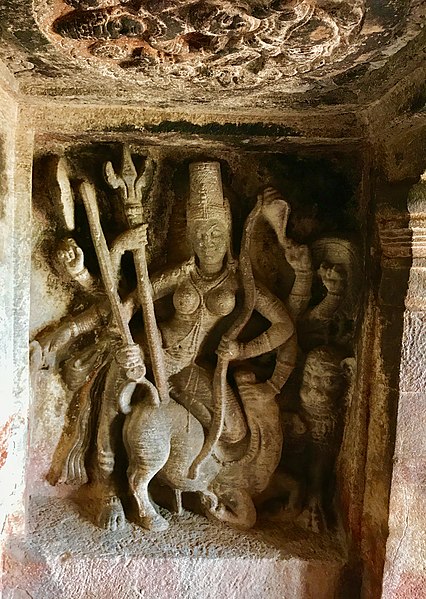
Original file (2,869 × 4,032 pixels, file size: 2.95 MB, MIME type: image/jpeg)
| This is a file from the
Wikimedia Commons. Information from its
description page there is shown below. Commons is a freely licensed media file repository. You can help. |
Summary
| Description6th century Ravanaphadi cave temple Shaktism, Durga spearing Mahisha buffalo demon, Aihole Hindu monuments Karnataka.jpg |
English: Aihole temples and monuments, also called Aivalli or Ayyavole or Aiholi temples and monuments, are a collection of over 100 temples built predominantly between 6th and 8th century near Malaprabha river in Karnataka. At this point, the river turns northwards towards the Himalayas which likely had significance as a location.
Though defaced and damaged after the region was conquered by Muslim commanders of the Delhi Sultanate, the collection is one of the earliest surviving temples and window to ancient Indian arts, religious beliefs, society and architecture. Almost all temples are related to Hinduism, but these co-exist with a few Jain temples of this period and one Buddhist monument. Both north Indian and south Indian styles fuse here, with monuments suggesting experimentation of ideas and building styles under the sponsorship of late Gupta period Hindu kingdoms, particularly the Calukyas and Rashtrakutas. The Ravanaphadi cave temple is a 6th century Hindu temple carved into a stone cave. It is dedicated to Shiva. The entrance is eroded likely from weather exposure and has two dwarapalas as well as a seated Nandi facing the Shiva linga inside. The inner part of the cave has a rectangular verandah followed by a square hall, a square garbhagriha and a square monastery like empty hall. The empty hall may have served as residence for sadhus / monks during monsoons or may indicate that the temple was left incomplete in early medieval times. The Ravanaphadi temple has one of earliest collection of key Hindu theological concepts in the region, such as Harihara or equivalence and unity of Shiva and Vishnu; Ardhanarishvara or equivalence of male and female principle (equal, necessary and dependent halves); divinity in arts through Nataraja showing Natya Shastra classical dance postures; Durga as Mahishasuramardini and Saptamatrikas (Shaktism, nature of evil and victory of good, seven aspects of protective mothers); the divine rescuing goddess earth (Vaishnavism, Varaha avatar lifting Bhudevi); and others. Vedic deities Indra and Indrani are carved in the ceiling, as are Vishnu and Lakshmi. Three major pan-Indian river goddesses are reverentially included. |
| Date | |
| Source | Own work |
| Author | Ms Sarah Welch |
| Camera location |
16° 01′ 21.36″ N, 75° 53′ 03.7″ E | View this and other nearby images on: OpenStreetMap |
|
|---|
Licensing
- You are free:
- to share – to copy, distribute and transmit the work
- to remix – to adapt the work
- Under the following conditions:
- attribution – You must give appropriate credit, provide a link to the license, and indicate if changes were made. You may do so in any reasonable manner, but not in any way that suggests the licensor endorses you or your use.
- share alike – If you remix, transform, or build upon the material, you must distribute your contributions under the same or compatible license as the original.
Captions
Items portrayed in this file
depicts
some value
9 September 2017
16°1'21.4"N, 75°53'3.8"E
0.06666666666666666666 second
1.8
3.99 millimetre
image/jpeg
ed5a67abef223ad3f5002d56fc11ed057fa1382a
3,095,041 byte
4,032 pixel
2,869 pixel
File history
Click on a date/time to view the file as it appeared at that time.
| Date/Time | Thumbnail | Dimensions | User | Comment | |
|---|---|---|---|---|---|
| current | 23:12, 27 September 2017 |
 | 2,869 × 4,032 (2.95 MB) | Ms Sarah Welch | User created page with UploadWizard |
File usage
Metadata
This file contains additional information, probably added from the digital camera or scanner used to create or digitize it.
If the file has been modified from its original state, some details may not fully reflect the modified file.
| Camera manufacturer | Apple |
|---|---|
| Camera model | iPhone 7 |
| Exposure time | 1/15 sec (0.066666666666667) |
| F-number | f/1.8 |
| ISO speed rating | 40 |
| Date and time of data generation | 14:36, 9 September 2017 |
| Lens focal length | 3.99 mm |
| Latitude | 16° 1′ 21.36″ N |
| Longitude | 75° 53′ 3.7″ E |
| Altitude | 523 meters above sea level |
| Orientation | Normal |
| Horizontal resolution | 72 dpi |
| Vertical resolution | 72 dpi |
| Software used | Photos 2.0 |
| File change date and time | 14:36, 9 September 2017 |
| Exposure Program | Normal program |
| Exif version | 2.21 |
| Date and time of digitizing | 14:36, 9 September 2017 |
| Meaning of each component |
|
| Shutter speed | 3.9094176851186 |
| APEX aperture | 1.6959937156324 |
| APEX brightness | 2.2646007151371 |
| Exposure bias | 0 |
| Metering mode | Spot |
| Flash | Flash did not fire, auto mode |
| DateTimeOriginal subseconds | 381 |
| DateTimeDigitized subseconds | 381 |
| Supported Flashpix version | 1 |
| Sensing method | One-chip color area sensor |
| Scene type | A directly photographed image |
| Exposure mode | Auto exposure |
| White balance | Auto white balance |
| Focal length in 35 mm film | 28 mm |
| Scene capture type | Standard |
| GPS time (atomic clock) | 09:06 |
| Speed unit | Kilometers per hour |
| Speed of GPS receiver | 0 |
| Reference for direction of image | True direction |
| Direction of image | 139.4371257485 |
| Reference for bearing of destination | True direction |
| Bearing of destination | 139.4371257485 |
| GPS date | 9 September 2017 |